Revell 1/32 Spitfire IIa
|
KIT #: |
? |
|
PRICE: |
$ |
|
DECALS: |
Three options |
|
REVIEWER: |
Tom Cleaver |
|
NOTES: |
Out of production. Used
Master Details 32016 1/32 Spitfire II horizontal
tail surfaces. |
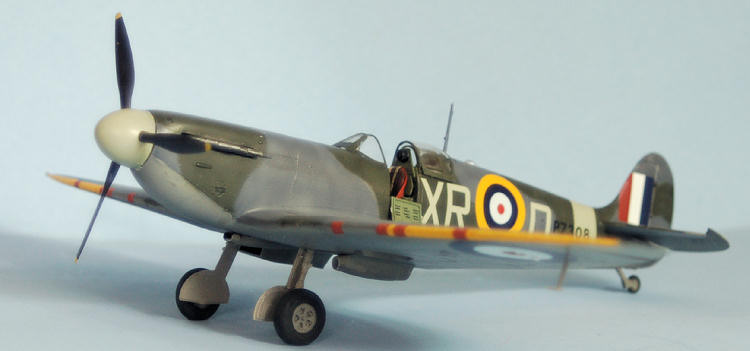
The Spitfire is the result of a failure.
The failure, the Type 224, was R.J. Mitchell’s first attempt to design an
all‑metal unbraced cantilever monoplane fighter.
Unfortunately, their Lordships of the Air Ministry had declared that the
type should be powered by the steam-cooled Goshawk engine, and put such
performance restrictions on the design as regards landing and takeoff speeds,
that the result was not even thoroughly pedestrian, but an abject failure.
As a result, in July 1934 Mitchell commenced work on the private design
of a much improved fighter, which was given the designation Type 300.
The design had a smaller wingspan, a retractable undercarriage, and an
enclosed cockpit. Over the course of a year, Mitchell continued to evolve the
design. A key feature adopted in
late 1934 was a broad elliptical wing, with an unusually thin section, which
theoretically gave the fighter
maximum aerodynamic efficiency with very little induced drag. Some histories of
the development of the Spitfire state the elliptical wing shape was developed
out of the need to carry eight machine guns in the wing, but in fact the wing
was designed for four machine guns and was a final part of the design before the
armament requirement was increased to eight weapons.
 In November 1934, Mitchell revised the design to use the promising new
Rolls‑Royce PV‑12 engine, later known as the Merlin.
With this final decision, the estimated performance of the new design was
such that Supermarine decided to proceed with a prototype as a private venture.
Within a month of receiving the initial data from Supermarine, the Air Ministry
wrote specification F.37/34 around the design to cover purchase of the Type 300
prototype. In April 1935, the Air Ministry issued the 8-gun armament
requirement.
In November 1934, Mitchell revised the design to use the promising new
Rolls‑Royce PV‑12 engine, later known as the Merlin.
With this final decision, the estimated performance of the new design was
such that Supermarine decided to proceed with a prototype as a private venture.
Within a month of receiving the initial data from Supermarine, the Air Ministry
wrote specification F.37/34 around the design to cover purchase of the Type 300
prototype. In April 1935, the Air Ministry issued the 8-gun armament
requirement.
The Type 300 prototype, serial K5054, first flew on March 5, 1936. Test
pilot ‘Mutt’ Summers commented ‘I don’t want anything touched’ – this actually
meant the prototype was a good basis for testing incremental improvements, not
that it was already perfect; further flight test revealed a number of problems
with the control surfaces and with wing flutter at high speed. In May 1936, the
Air Ministry agreed to the name “Spitfire” for the Type 300. On June 3, 1936,
the Air Ministry ordered production of 310 Spitfire Mk Is.
Putting the Spitfire into mass production was far more difficult than
originally anticipated. Supermarine had experience producing small batches of
virtually hand‑built aircraft, and almost all of Mitchell’s produced designs had
been one-offs. The beautiful elliptical wing was one of the greatest sources of
difficulty, since each rib was an individual size.
The reorganization of production consumed more time than expected, to the
dismay of the Air Ministry, who were pressing for early deliveries of the new
fighter. Adding to the difficulties, R. J. Mitchell died of cancer on
June 11, 1937. Responsibility for the further development of the Spitfire
became the responsibility of Mitchell’s assistant, Joseph Smith, who skillfully
managed the successful evolution of the aircraft through 40 different variants,
while retaining its essential fighting qualities.
Because of these production delays, 19 Squadron didn’t start receiving
Spitfire Mk Is at Duxford until
August 4, 1938,
and the RAF received only 49 Spitfires by
January 1, 1939.
By the summer of 1938, the production crisis resulted in the construction
of a huge new ‘Shadow Factory’ at Castle Bromwich, intend only for Spitfire
production. This factory commenced
production in 1940 with the Supermarine Type 329, known as the Spitfire II,
which was essentially a late-production Mk. I with the Merlin XII engine, and
was produced only at Castle Bromwich.
The main outward difference between the Mk. I and the Mk.II was the Mk.II
being equipped with a Rotol constant-speed propeller with a more bulbous
spinner, and a fairing on the starboard cowling over a Coffman cartridge
starter. 1000 Spitfire Mk IIs had
been produced by March 1941, when production switched over to the Spitfire V.
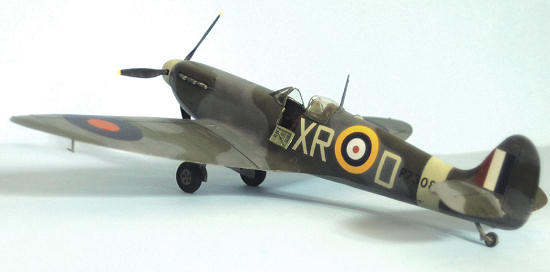 During the war, British propaganda purposely exaggerated the Spitfire’s
contribution to the
Battle
of
Britain.
This is nowhere more obvious than in the film, “The First of the Few,”
released in 1942, in which R. J. Mitchell is portrayed as a lone visionary
pursuing against all odds his quest to build the fighter he knows will be needed
to save
Britain
in the coming war. Certainly, the
Spitfire became the iconic symbol of
Britain’s
determination to win, and those Spitfires that survive today are treated like
the national treasures they are.
During the war, British propaganda purposely exaggerated the Spitfire’s
contribution to the
Battle
of
Britain.
This is nowhere more obvious than in the film, “The First of the Few,”
released in 1942, in which R. J. Mitchell is portrayed as a lone visionary
pursuing against all odds his quest to build the fighter he knows will be needed
to save
Britain
in the coming war. Certainly, the
Spitfire became the iconic symbol of
Britain’s
determination to win, and those Spitfires that survive today are treated like
the national treasures they are.
The Eagle Squadrons:
In the mythology of aerial warfare, the Eagle Squadrons - “the Yanks in
the RAF” - rank with the Lafayette Escadrille and the American Volunteer Group
for mystique. In fact, the Eagles
were far more like the young pilots of the Escadrille Lafayette - none of whom
were professionals before entering combat with the unit - than they were like
the Tigers of the AVG, all of whom were professional Army, Navy or Marine Corps
pilots, and whose mission was largely underwritten by the United States
government. For the young men who
joined the Eagle Squadrons, the act of crossing the border to
Canada
meant breaking the Neutrality Act; several were arrested by the FBI more than
once before successfully crossing over.
With the outbreak of war in 1939, Charles Sweeney, a wealthy American
businessman in
London,
organized the recruitment of Americans to join the French Air Force and fight in
the tradition of the
Lafayette
Escadrille. With the fall of
France,
a dozen of these recruits joined the RAF, including my father’s old schoolmate
Andy Mamedoff, “Red” Tobin and “Shorty” Keough, who had begun trying to join the
war by volunteering to fly for the Finns in the Winter War. (My father only
missed joining his friend due to the death of his father, and the sudden need of
his assuming responsibility of caring for his mother - since all the early
Eagles died in the war, I consider this fortuitous.)
By the summer of 1940, with the British government firmly in support of
getting as many Americans into RAF uniform as possible as props in the
propaganda effort to swing American domestic opinion in favor the the Allies,
Sweeney's operation was coordinated in Canada with the support of World War I
air ace Billy Bishop and in the United States with well-known aviation artist
Clayton Knight, who founded the Clayton Knight Committee. By
Pearl Harbor,
the Knight Committee had processed and approved 6,700 applications from
Americans to enter either the RCAF or RAF.
The cost of all this was about $100,000 in 1940s dollars (over a few
million today) and it was born completely by Sweeney and his rich society
contacts.
Most of those among the early volunteers were adventurers with some
flight experience, none of it up to military standards.
My old friend, the late film producer and agent Barry Mahon, told me he
had approximately 70 hours in light planes when he went to
Canada
during the
Battle
of
Britain.
He “padded” his flight log with 430 non-existent hours including 100 in
the “advanced” (controllable prop and retractable gear) Spartan Executive.
When he got to his Canadian training base, he was told to go fly a BT-16
Yale - which was far beyond his capabilities - and actually managed to take off,
make a circuit and put it back on
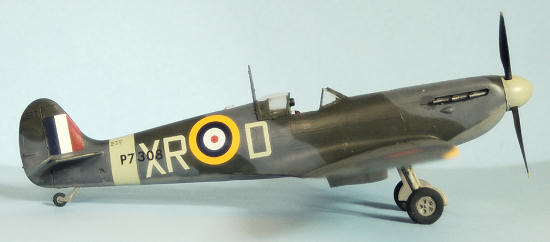 the ground
in one piece. Fortunately, the
instructors recognized his need for additional training.
Later, in 1941, many of those who went to
Canada
and joined the RCAF were cadets who had washed out of USAAC training schools;
the fact that several of them later became aces is indicative of either too-high
American standards, or better Canadian training.
the ground
in one piece. Fortunately, the
instructors recognized his need for additional training.
Later, in 1941, many of those who went to
Canada
and joined the RCAF were cadets who had washed out of USAAC training schools;
the fact that several of them later became aces is indicative of either too-high
American standards, or better Canadian training.
Nine Americans flew in the
Battle
of
Britain,
including Mamedoff, Tobin and Keough who were in 609 West Riding Squadron.
In November 1941, 71 “Eagle” Squadron was formed at Martlesham Heath.
The unit was originally equipped with Brewster Buffalos, which the young
Americans thought was terrific - American pilots going into battle in American
planes - until they flew the
Buffalo
and realized how bad it was. They
were glad to get Hurricane Is that December.
71 Eagle Squadron entered combat in May 1941, and the young Americans
quickly established themselves as more than poster boys for the propaganda war.
By August, they had demonstrated such potential that they were given
passed-down Spitfire IIs in place of the Hurricanes and assigned to the Biggin
Hill Wing. By September 1942, when
the Eagles - which then included 121 and 133 Squadrons - transferred to the
USAAF, they were credited with 73 victories and were the most combat-experienced
group of American fighter pilots in the Air Force. As the 4th Fighter
Group, they would go on to score 1.019.5 air and ground victories, an American
record that will likely never be equaled.
Bill Dunn:
America’s
First Ace of World War II:
Born in
Minneapolis
on
November 16, 1916,
Bill Dunn ran away from home in 1934, at the age of 17, and joined the
U.S.
Army, being discharged in 1936.
With the outbreak of war in 1939, he joined the Canadian Army as a member of the
Seaforth Highlanders, a Scottish infantry regiment of the 3rd Brigade, 1st
Canadian Division. Arriving in
Britain
in April 1940, he trained as an AA gunner and claimed ‑ with other gunners ‑ two
Ju-87's shot down while attacking Borden army camp on
August 16, 1940.
In September, Dunn transferred to the RAF, and completed training in
April 1941, then being sent to 71 “Eagle” Squadron based at Martlesham Heath.
The working class Dunn did not fit in with the somewhat cliquish young
members of the unit, many of whom were the products of private school
educations, and all of whom were better-educated than he; most importantly, he
got off on the wrong foot with Flight Lieutenant Chesley Petersen, the
highest-ranking American in the unit who had just become a Flight Leader and was
the center of the dominant “clique” in the unit.
Dunn’s relationship with the Eagles was further exacerbated by the fact
he was an uncommonly-good pilot, as shown when he became the first pilot in the
squadron to shoot down an enemy aircraft, on July 2, 1941.
By early August, Dunn’s score stood at 3, and he was tied with Gus
Daymond for leading scorer.
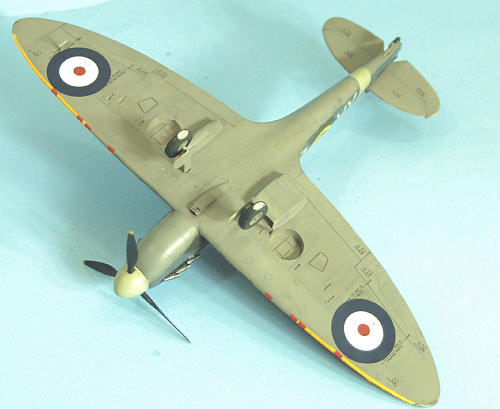 On the basis of their performance in the preceding two months, 71
Squadron was issued with Spitfires on
August 17, 1941,
and assigned to the Biggin Hill Wing.
On August 27, 1941,
in a swirling dogfight over northern
France,
Dunn shot down two Bf-109Fs, to become the first American ace of the war.
However, he was badly wounded in the right leg during the fight, and
crash-landed at Manston, from where he was immediately sent to the hospital for
what became a lengthy recovery that lasted into 1942.
In the meantime, the more popular Daymond managed to score two victories
in early September, and was proclaimed the first American Ace by his comrades.
This mistake in the history books would not be corrected officially until
1969, when the American Fighter Aces Association verified Dunn’s claims.
On the basis of their performance in the preceding two months, 71
Squadron was issued with Spitfires on
August 17, 1941,
and assigned to the Biggin Hill Wing.
On August 27, 1941,
in a swirling dogfight over northern
France,
Dunn shot down two Bf-109Fs, to become the first American ace of the war.
However, he was badly wounded in the right leg during the fight, and
crash-landed at Manston, from where he was immediately sent to the hospital for
what became a lengthy recovery that lasted into 1942.
In the meantime, the more popular Daymond managed to score two victories
in early September, and was proclaimed the first American Ace by his comrades.
This mistake in the history books would not be corrected officially until
1969, when the American Fighter Aces Association verified Dunn’s claims.
Following brief service with 130 Squadron, Dunn became an instructor at
various locations in
Britain
and the
United States,
before joining the USAAF on June 15, 1943.
He became Group XO of the newly-organized 40t6th Fighter Group in
October, 1943, and moved back to
Britain
with the unit in the Spring of 1944 as part of the tactical 9th Air
Force. The unit moved to
France
following the invasion. After
scoring a sixth victory that summer and sharing a seventh, Dunn scored his final
victory in the war by shooting down a Bf-110 with a salvo of 5-inch rockets in
October 1944. By the end of the war
his score was 8.5 kills, 3 probables, 12 destroyed on the ground, over the
course of 234 missions.
Sent to
China
in 1945 to advise the Nationalist Air Force, Dunn flew with the Nationalists
until the end of the Civil War in 1949.
In the 1950s, he helped train the Iranian Imperial Air Force and the
Brazilian Air Force. Dunn’s final
combat duty was in Vietnam in 1967, with Headquarters, 7th Air Force,
where he flew 62 missions over the Ho Chi Minh Trail evaluating infra red
location equipment. After 38 years’
service and 378 combat missions, LCOL William Dunn retired from the USAF in
1973. His autobiography, Fighter
Pilot: The First American Ace of World War II, is well worth tracking down and
reading.
The 1/32 Revell Spitfire Ia/IIa was developed by Revell-Germany, based on
the Hasegawa Spitfire Vb. The main
difference being that the wing was modified to the 8-gun “A” wing, with engraved
panel lines. The kit has been in
and out of production over the years, and is currently not in production.
It can occasionally be found on dealer’s tables at model shows, and is
worth picking up. This kit should
not be confused with the Revell Spitfire I that has been released recently on
their “Classic” list - this is the ancient 1969 release that is not at all up to
modern standards in terms of accuracy or detail.
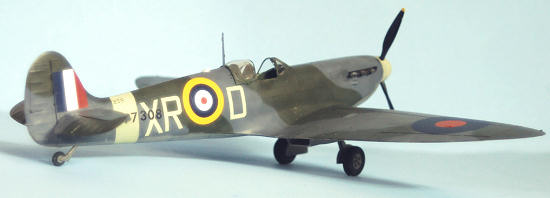 The kit is simple to build. My only deviations from an OOB project were
to use the leftover PCM seat, and an Eduard photoetch Sutton Harness, and the
Master Details aftermarket resin horizontal stabilizer and elevators, which
considerably ease posing the elevators as drooping.
The kit is simple to build. My only deviations from an OOB project were
to use the leftover PCM seat, and an Eduard photoetch Sutton Harness, and the
Master Details aftermarket resin horizontal stabilizer and elevators, which
considerably ease posing the elevators as drooping.
The PCM seat is based on the original Hasegawa seat with some additional
detail; it is actually about one-third too large, though it works with this kit
since it fills up space that would otherwise show the paucity of kit-provided
internal cockpit detail.
I also rescribed the raised detail on the fuselage, to match that of the
modified wing.
Painting:
There has been over the years considerable confusion about the camouflage
and markings of Dunn’s Spitfire IIa P7308, in which he scored the two victories
that made him an ace. That Dunn
himself helped with these mistakes with his painting of his airplane - which
many at the time assumed must be right since it was done by the man who had
flown it - has not made things easier.
Aeromaster compounded the mistake when they released their 1/48 sheet of
American Eagle Squadron airplanes, in which they accepted Dunn’s depiction of
the airplane.
What Dunn created in his painting (it’s the cover art of his book)is a
Spitfire IIa in the early Dark Green/Dark Earth/Sky camouflage.
However, the Eagles received their Spitfires after August 15, 1941,
which is an important date in the history of RAF camouflage.
That is because on that date, all RAF fighters were to be repainted in
the new “Temperate Day Scheme” of a
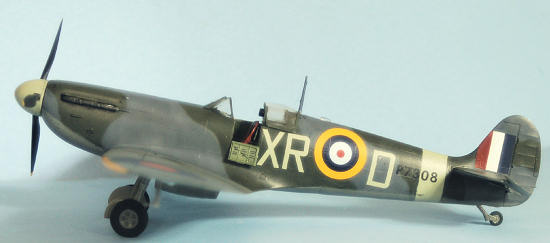 disruptive
upper pattern of Dark Green and the new Ocean Grey, with the lower surfaces
painted Sea Grey Medium. There was
at the time a shortage of the new Ocean Grey, and so the directive stated that
the upper color could also be a “Mixed Grey” obtained with a 50-50 mixture of
Sea Grey Medium and Night (Black).
Since all of this was done “in the field,” the results differed markedly from
unit to unit, with the upper color ranging from a very light to a very dark
grey. In the old Profile
publication, “Camouflage and Markings: Spitfire in Northern Europe,” one of the
profiles is of P7308, and it is the only source that clearly states that the
colors were most likely Mixed Grey and Dark Green upper surfaces with Sea Grey
Medium lower surfaces. This marking
was also followed by Roy Sutherland when he developed the pre-painted Spitfire
II model for 21st Century Toys several years ago.
disruptive
upper pattern of Dark Green and the new Ocean Grey, with the lower surfaces
painted Sea Grey Medium. There was
at the time a shortage of the new Ocean Grey, and so the directive stated that
the upper color could also be a “Mixed Grey” obtained with a 50-50 mixture of
Sea Grey Medium and Night (Black).
Since all of this was done “in the field,” the results differed markedly from
unit to unit, with the upper color ranging from a very light to a very dark
grey. In the old Profile
publication, “Camouflage and Markings: Spitfire in Northern Europe,” one of the
profiles is of P7308, and it is the only source that clearly states that the
colors were most likely Mixed Grey and Dark Green upper surfaces with Sea Grey
Medium lower surfaces. This marking
was also followed by Roy Sutherland when he developed the pre-painted Spitfire
II model for 21st Century Toys several years ago.
There is the additional fact that the Spitfire II was the last Spitfire
produced that was painted in the factory in the “A” and “B” scheme, which were
mirror images of each other.
Aircraft with a serial ending in an odd number received the “A” scheme, while
those with an even-number serial were painted in the “B” scheme.
Therefore, what is most likely is that on
August 27, 1941,
P7308 was painted in the “B” scheme camouflage, with upper colors Mixed Grey and
Dark Green, with lower surfaces Sea Grey Medium. Since these colors would have
been applied at the base level, they would also have been “freehanded” with a
spray gun, resulting in soft edges for all three colors - with Mixed Grey
overspray on the Dark Green, which would have been the only color not repainted.
After pre-shading the model with flat black, I used Tamiya “J.A. Green”
to get a Sky Band and Spinner that were close to the color of “Sky” in the
Xtradecals sheet of code letters I used.
I also painted the leading edge of the wing with Tamiya Flat Yellow.
The wing edge and fuselage band were then marked off, and the camouflage
was applied. I used Xtracrylix for
the camouflage, applying the RAF Dark Green first, followed by Sea Grey Medium,
then my “Mixed Grey” which I did mixing Sea Grey Medium and Night.
After all was dry, I unmasked and applied three coats of Xtracrylix Gloss
Varnish.
Decals:
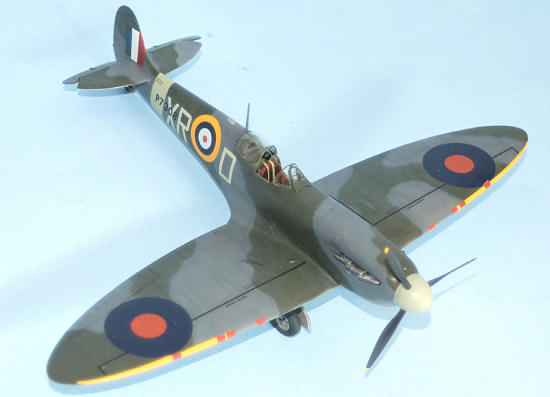 I used the kit decals for the stencils and national markings.
I cut up the different sets of serials on that sheet to get “P7308", and
used large Type A roundels from an Aeromaster sheet for the underwing markings.
71 Squadron did use a white bade on the left cowling of their Spitfires,
taken from their uniform shoulder patch.
There is a question of when this was applied, with a comment made in one
book that it wasn’t till September 1941.
Additionally, Dunn’s book shows him standing in front of a Spitfire nose
where that marking is not visible (and should be) - whether that Spitfire is
P7308 is unknown. In the end, I
didn’t have the decal, or a way of making it, so it remains off until I can
change that situation.
I used the kit decals for the stencils and national markings.
I cut up the different sets of serials on that sheet to get “P7308", and
used large Type A roundels from an Aeromaster sheet for the underwing markings.
71 Squadron did use a white bade on the left cowling of their Spitfires,
taken from their uniform shoulder patch.
There is a question of when this was applied, with a comment made in one
book that it wasn’t till September 1941.
Additionally, Dunn’s book shows him standing in front of a Spitfire nose
where that marking is not visible (and should be) - whether that Spitfire is
P7308 is unknown. In the end, I
didn’t have the decal, or a way of making it, so it remains off until I can
change that situation.
Final Finish:
Since this airplane was only with 71 Squadron for 12 days after a
complete repaint, I did not “ding” the model, but did apply Tamiya “Smoke” for
the exhaust stains and the oil stains on the belly and rear fuselage.
I then gave the model two coats of Xtracrylix Flat varnish.
I wish Revell-Germany would bring back this kit, since it can form the
basis for doing “C” wing early Spitfires without a lot of surgery to remove the
bumps and bulges of a “B” wing, not to mention this is the best early Spitfire
kit in this scale, being far superior to the old “classic” kit now being sold.
At any rate, it makes a very interesting juxtaposition to pose this next
to the “Super Spitfire”, the Mk. XVIII, and see all the changes that happened in
10 years of development.
Review Kit Courtesy of my wallet.
Tom Cleaver
July 2010
Copyright ModelingMadness.com. All rights reserved. No reproduction in any form without express permission from the editor.
If you would like your product reviewed fairly and quickly, please
contact
the editor or see other details in the
Note to
Contributors.
Back to the Main Page
Back to the Review
Index Page 2025




 the ground
in one piece. Fortunately, the
instructors recognized his need for additional training.
Later, in 1941, many of those who went to
the ground
in one piece. Fortunately, the
instructors recognized his need for additional training.
Later, in 1941, many of those who went to 
 The kit is simple to build. My only deviations from an OOB project were
to use the leftover PCM seat, and an Eduard photoetch Sutton Harness, and the
Master Details aftermarket resin horizontal stabilizer and elevators, which
considerably ease posing the elevators as drooping.
The kit is simple to build. My only deviations from an OOB project were
to use the leftover PCM seat, and an Eduard photoetch Sutton Harness, and the
Master Details aftermarket resin horizontal stabilizer and elevators, which
considerably ease posing the elevators as drooping.
 disruptive
upper pattern of Dark Green and the new Ocean Grey, with the lower surfaces
painted Sea Grey Medium. There was
at the time a shortage of the new Ocean Grey, and so the directive stated that
the upper color could also be a “Mixed Grey” obtained with a 50-50 mixture of
Sea Grey Medium and Night (Black).
Since all of this was done “in the field,” the results differed markedly from
unit to unit, with the upper color ranging from a very light to a very dark
grey. In the old Profile
publication, “Camouflage and Markings: Spitfire in Northern Europe,” one of the
profiles is of P7308, and it is the only source that clearly states that the
colors were most likely Mixed Grey and Dark Green upper surfaces with Sea Grey
Medium lower surfaces. This marking
was also followed by Roy Sutherland when he developed the pre-painted Spitfire
II model for 21st Century Toys several years ago.
disruptive
upper pattern of Dark Green and the new Ocean Grey, with the lower surfaces
painted Sea Grey Medium. There was
at the time a shortage of the new Ocean Grey, and so the directive stated that
the upper color could also be a “Mixed Grey” obtained with a 50-50 mixture of
Sea Grey Medium and Night (Black).
Since all of this was done “in the field,” the results differed markedly from
unit to unit, with the upper color ranging from a very light to a very dark
grey. In the old Profile
publication, “Camouflage and Markings: Spitfire in Northern Europe,” one of the
profiles is of P7308, and it is the only source that clearly states that the
colors were most likely Mixed Grey and Dark Green upper surfaces with Sea Grey
Medium lower surfaces. This marking
was also followed by Roy Sutherland when he developed the pre-painted Spitfire
II model for 21st Century Toys several years ago.